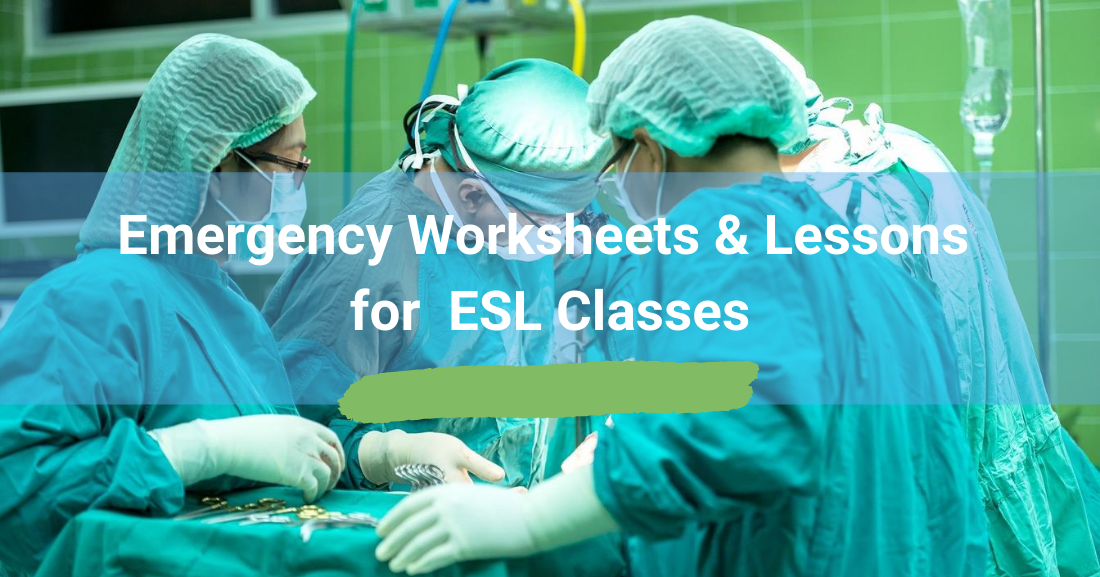
As an ESL teacher, one of your many functions is to equip your students with language skills for navigating daily life. One of these unpleasant but highly important parts of life is an emergency, especially because in high-stress or emotional situations, all language skills can vanish into thin air: Where a student could confidently express themselves in a classroom, has quickly devolved into stutters, forgotten vocabulary, and an inability to express the situation or need.
No matter what age your ELS students, it's imperative that they can discuss all kinds of emergency situations - from natural disasters and public safety to medical and health matters.
Knowing how to report an emergency is essential for all levels of students, so help equip your students for any eventuality with these emergency worksheets and lessons for ESL that focus on introducing critical new vocabulary and phrases, as well as teaching them how to approach handling matters concerning their own safety and the safety of others. So, without further delay, let's dive in.
Building Vocabulary for Emergencies
One of the first places to start when teaching the language of emergencies is vocabulary. Take a look at this Puzzle Resource for beginners, or this Emergencies Cut-and-Paste for young students. Once vocabulary has been established, we can then move on to expressing concerns.
Getting Help in an Emergency
It's especially important for beginner students to learn about getting help in an emergency early on in their education. This often takes place in their mother tongue, but should not be neglected in ESL studies.
Children are often the most defenseless population, so equipping them with the appropriate language and tools to communicate a safety concern is one of the most impactful things you can do for your students.
We recommend starting with this simple First Aid Kit worksheet. Young students will likely recognize many of the supplies shown in this activity, but it is helpful to practice the vocabulary and discuss how each item can be used to help in an emergency situation.
Another resource we love is this resource containing multiple activities focused on emergencies. From true and false sections to fill-in-the-blanks, these exercises will help solidify beginner students’ awareness and knowledge of vocabulary related to emergencies.
Another awesome emergency worksheet goes over how to report a safety concern over the phone. This is one of the most helpful skills a child can have and can potentially save someone's life.
Note: Discussing emergencies with young children may bring up fear and insecurity, so be sure to assure students that these situations are unlikely to occur. But if they do, they should feel confident in knowing they are empowered to handle them with their newfound knowledge.
Nevertheless, a little gamified role play goes a long way in making practice a fun and memorable experience, which is why we love this Emergencies Game resource that splits classes into groups and sees each team answering questions.
Emergency Services (Fire department, Police Station, Etc.)
On the same note as getting help in an emergency, it is important to teach ESL students about emergency services that they can reach out to in the event that something bad happens, like the fire department and the police station. A great place to start is with this Emergency Services role-play activity. They will learn about and act out possible scenarios that could take place with police officers, an ambulance and paramedic, firefighters, and more.
After introducing these emergency services, you can use this Fire Safety Checklist Project to give students a better idea of what to do in the case of a fire. They will work on identifying potential fire hazards, as well as locating safety devices like fire alarms.
Another fire safety resource we love is this one centered on Sesame Street. This color and learn resource pack provided by Federal Emergency Management Agency and Sesame Workshop teaches students how to escape from a fire, smoke alarms, and stop-drop-and-roll, amongst other things.
In this next activity, students will practice a conversation on reporting a past crime. This exercise provides reading, speaking, gap-fill writing, and role-play activities. While most students will hopefully never have to be in a situation to report a past crime, this activity will give them greater confidence in talking to police officers if a situation ever arises where they need to do so.

Natural Disasters
Depending on where your ESL students live, they may never experience a hurricane or cyclone, a tornado, or an earthquake. But knowing how to talk about natural disasters and being prepared for extreme weather patterns is never a bad idea (especially if they plan on traveling to other parts of the world that may experience different kinds of weather!).
To introduce this topic to students, start with this Natural Disaster Worksheet. Several exercises are covered in this resource, such as:
-
Preparing for a disaster
-
Family communications plans
-
Taking care of pets
- Making a disaster supplies kit
- Preventing fires
- Floods
- Thunderstorms
- Tornadoes
- Hurricanes
- Winter Storms
- Earthquakes
Feel free to use as many or as few of the resources, depending on what you are hoping to accomplish with your lesson - like these Disaster Preparedness Coloring Pages. If you want to focus in on specific natural disasters, you can use this earthquake preparedness worksheet or this hurricanes worksheet. Both discuss what happens when the natural disaster takes place, its impact on affected areas, and how to stay safe if you come into contact with extreme weather patterns. Students will practice new vocabulary with true or false, fill in the blank, and open ended questions.
We have whole categories of natural disasters for you to explore, such as Tsunamis and Earthquakes, so check them out.
Medical & Health Emergencies
Discussing medical and health emergencies with ESL students may be the most applicable topic that you teach them on this list. Since we've already gone over how to report an emergency above, we’lll focus on some more specific topics that will broaden students’ vocabulary when it comes to things like injuries and fractures to the current pandemic that we are living in. Because of how relevant it is, teaching students words that go with the covid-19 pandemic is a must if you're teaching in 2022. In this emergency worksheet, pre-intermediate to advanced students will be introduced to terms like:
-
Sneezing
-
Pandemic
- Self-isolation
- Vaccination
- Anti-vaxxers
- Quarantine
- Double-vaxxed / Double-jabbed
- Pneumonia
- Fever
- Variants
There are countless conversation activities that you can do surrounding pandemic-related vocab. And if you're discussing medical and health emergencies, this is a great time to have conversations about going to the hospital, as well. With this hospital worksheet, students will go through a picture based sequencing activity. The exercise gives ESL students practice with speaking, writing, storytelling, and learning comprehension.
Just a final thought - as you are teaching students about emergencies and how to be safe during one, keep in mind that students may have experienced similar situations in their lives. As always, be aware of how your students are responding to certain activities and don't force them to talk about anything they are not comfortable with. In most cases however, students will enjoy learning about how to remain safe in scary and unprecedented situations. These lessons often help them to feel more confident and knowledgeable.
If you want to learn more about teaching about high-stress, scary situations like visiting the ER or witnessing a crime, check out these Valuable Activities for Teaching about Emergencies.
If you liked what you read and want more, why not read our lesson ideas for Household Dangers.
P.S. If you enjoyed this article, please help spread it by clicking one of those sharing buttons below. And if you are interested in more, you should follow our Facebook page where we share more about creative, non-boring ways to teach English.







